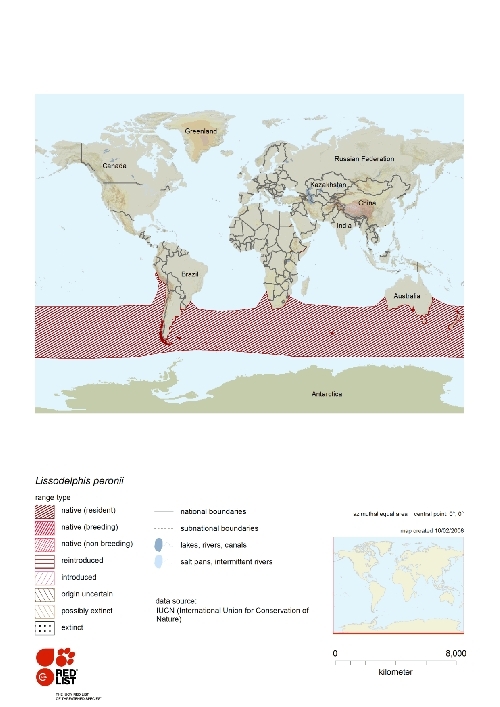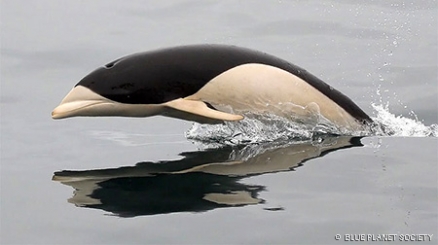Southern right whale dolphin
 Southern right whale dolphin. Source: World Register of Marine Species/Encyclopedia of Life Southern right whale dolphin. Source: World Register of Marine Species/Encyclopedia of Life
|
 Southern right whale dolphin size comparison. Source: Chris Huh Southern right whale dolphin size comparison. Source: Chris Huh
|
|
Conservation Status: |
|
Scientific Classification Kingdom: Animalia (Animals) |
The Southern right whale dolphin is a cetacean most well known forlacking a dorsal fin. One of the most slender of all cetaceans, these dolphins are most often found in large herds ranging from 100 to 200 dolphins, however, they have been found in groups as large as 3000 individuals.
The Southern right whale dolphinsis a sister species to the Northern right-whale dolphin. The differences between the two species are their sizes, geographic location, and coloration. The southern right whale dolphin prefers the Southern hemisphere because of its cooler temperatures, have more striking coloration patterns, and are larger in size.
Contents
Physical Description
The Southern right whale dolphin is mostly black dorsally and white ventrally. The beak, anterior melon, and flippers are white. A black band is seen on the trailing edge of the flippers as well. Gray coloration is sometimes seen on the dorsal surface of the flukes as opposed to black. Several different color variants have been reported in this species including: those with white spots on the head, or variations in the amount of black and white on the body and fins. Calves have been reported to possess a muted color pattern of brown or gray instead of black and white.
The genus name Lissodelphis refers to the fact that both species of right whale dolphin (northern and southern) are characterized by complete absence of a dorsal fin or dorsal ridge. Southern right whale dolphins along with their northern counterpart are the most slender of all cetaceans. They have a dorso ventrally compressed body, a straight mouthline, a short beak, small recurved flippers with pointed tips about one fourth of the way back from the snout tip, and small concave flukes with a deep to medium notch. Southern right whale dolphins have reached a reported 2.97 meters in length, and males tend to grow larger than females.Teeth are small, slender and sharp. In general, there are slightly more teeth in the lower jaw.
Reproduction
Unfortunately very little is known of the reproductive biology of the Southern right whale dolphin.
Lifespan
The Southern right-whale dolphin's lifespan is unknown.
Behavior
Southern right whale dolphins are highly gregarious. They are seen singly, but most often are in groups of up to 1000. Mean herd size was found to be 210 individuals. Herd configurations vary. They may be tightly packed groups, or in v-formations, or "chorus lines." Southern right whale dolphins along with their northern counterpart are most often found in association with dolphins of the genusLagenorhynchus, and with the pilot whale.
Slow swimming behavior typically involves exposure of the head and blowhole only to respire. Fast moving herds may swim just below the surface, rapidly surface to breathe, then resubmerge. While in fast swimming mode, herds may also swim rapidly at the surface where they perform low angle leaps, belly flops, fluke slaps, side slaps, and they occasionally bowride.
Although Northern right whale dolphins have been described to produce clicks, vocalizations of Southern right whale dolphins have not been reported.
Distribution
 The Southern right whale dolphin has a circumpolar distribution, and is found only in cool, temperate subtropical to subantarctic waters of the Southern Hemisphere. The southern limit of the species distribution is generally bounded by the Antarctic Convergence. The northward counterclockwise flowing Humboldt and Benguela current systems may allow this coldwater species to extend its range northward along the west coast of the Southern Hemisphere continents. This is an open ocean species coming close to shore only in deep water coastal areas.
The Southern right whale dolphin has a circumpolar distribution, and is found only in cool, temperate subtropical to subantarctic waters of the Southern Hemisphere. The southern limit of the species distribution is generally bounded by the Antarctic Convergence. The northward counterclockwise flowing Humboldt and Benguela current systems may allow this coldwater species to extend its range northward along the west coast of the Southern Hemisphere continents. This is an open ocean species coming close to shore only in deep water coastal areas.
Habitat
Southern right whale dolphins reside most often in cool, deep, offshore waters of the Southern Hemisphere with temperatures of one to twenty degrees celsius. They are sometimes observed nearshore, especially where deep water approaches the coast.
Ecosystem Roles
Southern right whale dolphins often school with the Pacific white-sided dolphin. They are also often found with the Dusky dolphin and the Pilot whale.
Feeding Habits
Southern right whale dolphins prey primarily on mesopelagic fishes, especially lanternfish, (family Myctophidae) and cephalopods such as squid. They may dive to depths in excess of 200 m in search of food. Entire schools have been observed to dive for as long as six minutes and 30 seconds.
Conservation Status
The IUCN lists this species as Data Deficient.
Threats
Preliminary boat surveys suggest that the Southern right whale dolphin may be one of the most common cetaceans in northern Chilean coastal waters. Increasing numbers of southern right whale dolphins have stranded on beaches of north-central Chile in the last few years, some have been returned to sea alive, but it is not known if they survived.
It is not confirmed, but likely that killer whales and possibly large sharks are predators for the Southern right whale dolphin.Southern right whale dolphins are reportedly infrequently caught off the coasts of Peru and Chile, where they are used as food or crab bait. Also they were occasionally taken for food by whalers in the 1800's, although now they appear to be nowhere heavily hunted.
References and Further Reading
- IUCN Red List: Lissodelphis peronii
- NOAA, Southern Right Whale Dolphin (Lissodelphis peronii)
- EOL, Lissodelphis peronii (Lacepede, 1804) Northern right-whale dolphin
- Marine Bio Right Whale Dolphin, Lissodelphis borealis
- Banks, R. C., R. W. McDiarmid, A. L. Gardner, and W. C. Starnes. 2003. Checklist of Vertebrates of the United States, the U.S. Territories, and Canada
- Banks, R. C., R. W. McDiarmid, and A. L. Gardner. 1987. Checklist of Vertebrates of the United States, the U.S. Territories, and Canada. Resource Publication, no. 166. 79
- Don Wilson and Sue Ruff (1999) The Smithsonian Book of North American Mammals. Smithsonian Books: Washington.
- Foster, L. 1948. The World's Whales. London: Hart-Davis and MacGibbon.
- Gill, 1865. Proceedings of the Academy of Natural Sciences of Philadelphia, 17:177.
- IUCN (2008) Cetacean update of the 2008 IUCN Red List of Threatened Species.
- Leatherwood, S., R. Reeves. 1983. Whales and Dolphins. San Francisco: Sierra Club Books.
- Mead, James G., and Robert L. Brownell, Jr. / Wilson, Don E., and DeeAnn M. Reeder, eds. 2005. Order Cetacea. Mammal Species of the World: A Taxonomic and Geographic Reference, 3rd ed., vol. 1. 723-743
- Perrin, W. (2010). Lagenorhynchus obliquidens Gill, 1865. In: Perrin, W.F. World Cetacea Database. Accessed through: Perrin, W.F. World Cetacea Database
- Rice, Dale W. 1998. Marine Mammals of the World: Systematics and Distribution. Special Publications of the Society for Marine Mammals, no. 4. ix + 231
- Richard Weigl (2005) Longevity of Mammals in Captivity; from the Living Collections of the World. Kleine Senckenberg-Reihe 48: Stuttgart.
- UNESCO-IOC Register of Marine Organisms
- Watson, L. 1981. Sea Guide to Whales of the World. London: Hutchinson.
- Wilson, Don E., and DeeAnn M. Reeder, eds. 1993. Mammal Species of the World: A Taxonomic and Geographic Reference, 2nd ed., 3rd printing. xviii + 1207
- Wilson, Don E., and F. Russell Cole. 2000. Common Names of Mammals of the World. xiv + 204
- Wilson, Don E., and Sue Ruff, eds. 1999. The Smithsonian Book of North American Mammals. xxv + 750
Portions of this article was researched by a student at Texas Tech University participating in the Encyclopedia of Earth's Student Science Communication Project. The project encourages students in undergraduate and graduate programs to write about timely scientific issues under close faculty guidance. All articles have been reviewed by internal EoE editors, and by independent experts on each topic.
